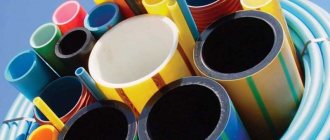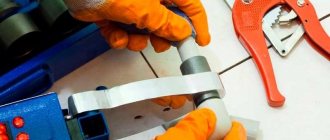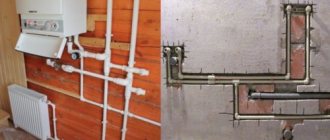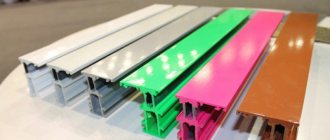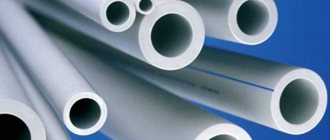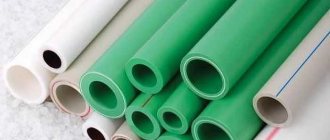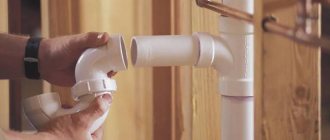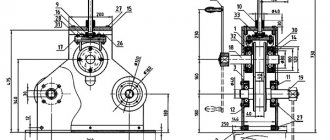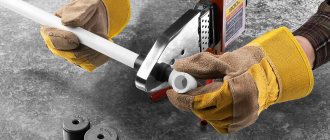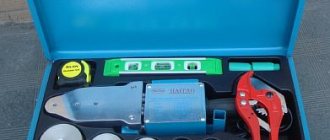Private housing, apartments and houses are equipped through the use of utilities. The problem of installation, reconstruction and repair at each of the facilities requires repair or installation of a water supply and heating system. Modern technologies have offered facility owners and installation specialists an alternative, more cost-effective and convenient solution - polypropylene pipes. Correct installation determines that heating circuits and plumbing are not inferior to other options in terms of performance properties. According to certain parameters, there is a significant superiority of polypropylene structures over steel ones. The process of soldering pipes is not difficult and does not require professional knowledge or special skills. It is discussed in the instructions below.
Welding machines for polypropylene pipes
Let's start by preparing the installation tool.
Since all connections of PPR pipes and fittings are made by soldering, you will need a special soldering iron for this purpose. The welding machine used for polypropylene pipes is offered on the market in two types:
- with a round heater;
- flat heating element.
The latter was popularly nicknamed “iron” due to some external resemblance to this household appliance. Different welding machines have no fundamental differences, only structural differences. In the first case, nozzles for Teflon pipes are put on and attached to the heater like clamps, and in the second case they are screwed to it on both sides. Otherwise, there is not much difference, and the device has one function - soldering polypropylene.
Soldering machines are usually sold complete with attachments. The cheapest and minimal kit made in China is a soldering iron with a power of up to 800 W, a stand for it and nozzles for 3 sizes of the most common pipes - 20, 25 and 32 mm. If your heating scheme contains only such diameters and you do not plan to solder polypropylene pipes anywhere other than your home, or do it professionally, then a budget set will be quite enough.
If, in accordance with the calculation and diagram, you need to join pipes of sizes 40, 50 and 63 mm, then you will have to spend money and purchase another soldering kit, which contains the corresponding parts. Well, the most expensive kits are produced in European countries and are distinguished by their reliability and durability. Similar kits include the following tools:
- soldering iron with stand;
- Teflon nozzles for soldering iron of all the above diameters;
- scissors for cutting pipes at a precise angle of 90º;
- hex wrench;
- Phillips screwdriver;
- roulette;
- gloves.
The working part of a soldering iron (heater) of any design is designed in such a way that 2-3 nozzles for small-diameter pipes can be installed on it. This allows you to save a lot of time when working with lines ranging in size from 20 to 40 mm.
A little about the power of the soldering machine. High power is necessary for quick and uniform heating of large diameter parts, which are considered to be sizes 63 mm or more. For home purposes, it is enough to have an iron with a power of 0.7-1 kW. Soldering irons with heaters above 1 kW are considered professional, and accordingly, they are more expensive than regular ones.
Which polypropylene products to choose
For low-pressure cold water supply networks, PN16 products are the most practical. They can easily withstand pressure up to 2 atmospheres at temperatures up to +40 degrees. This is quite enough to withstand the loads of a water supply system in a private home or a watering system in a greenhouse or garden.
Polypropylene products of the PN20 brand are more resistant to various influences, which are considered universal and can be used, among other things, for heating with a coolant temperature of up to 95 degrees.
But the most reliable pipes in any water supply system are PN25 pipes reinforced with aluminum or fiberglass.
How to connect a metal-plastic pipe with a polypropylene pipe
Due to various circumstances, it happens that it is necessary to connect different types of pipes, for example, PPR and steel, metal-plastic with polypropylene, and so on. Such situations happen in apartments where it is difficult to change a section of a common water supply or heating riser laid with a steel or metal-plastic pipe, but you need to connect to it. This is not a big problem, you just need to take into account that all such connections are made through threaded fittings.
Since metal-plastic pipes can be connected using press and dismountable fittings, for joining with polypropylene it is more convenient to use a detachable fitting with an external thread. In turn, a fitting with an external thread is soldered to the end of the polypropylene pipe, after which the connection is twisted in the traditional way, with flax or fum tape wound up.
Detachable fitting for connecting pipes
When you need to cut into metal-plastic pipes, it is most convenient to install a tee with a threaded outlet, where you can subsequently screw the fitting, and then solder the polypropylene pipe to it. True, you will have to tinker with the installation of the tee: you need to turn off the water or empty the heating system, and then cut the metal-plastic and carry out the installation.
Types of reinforcement
Today there are two types of reinforcement:
Each type of reinforcement gives the product certain properties.
Aluminum
Polypropylene pipes reinforced with aluminum consist of several layers, between which aluminum foil is located. The layers are glued together with polypropylene glue.
Note! The quality of multilayer products largely depends on the quality of the adhesive joint. Therefore, it is not uncommon for cheap pipes to delaminate under certain operating conditions.
It must be said that aluminum reinforcement comes in two types:
Fiberglass
Fiberglass is an alternative to aluminum. As in the previous case, there are layers of polypropylene on the outside and inside of the product, and a layer of fiberglass on the inside. Moreover, all layers are monolithic.
The inner layer of these products is welded to the outer and inner. As a result, polypropylene holds the fiberglass fibers together, and the fiberglass, in turn, prevents it from deforming. Unlike the previous type of reinforcement, when using fiberglass, no glue is used.
The disadvantage of fiberglass is that it increases the weight of the product, but its price is slightly reduced. True, the cost largely depends on the manufacturer.
In addition, it should be noted that the fiberglass-reinforced heating pipeline saturates the coolant with oxygen, as a result of which the boilers rust. However, according to many experts, this problem is more far-fetched than real, since there are no specific figures.
Socket welding of polypropylene pipes
The main method of installing plastic, when it is necessary to connect small cylindrical products of different sections, is the use of a socket. When welding a PP structure, additional parts must be used:
- corners;
- tees;
- bends.
They are all made from the same material from which the pipes were made. The use of additional elements to create a high-quality connection is not considered a disadvantage of this method. The parts in question, in addition to the connecting function, help change the direction of the pipeline.
This process consists of several operations:
- the mating surfaces are melted: the outer wall of the cylindrical product with the inner part of the fitting;
- special heating parts are used;
- The assembled elements are cooled.
According to professionals, socket joints are considered much more reliable than butt welding. Due to the fact that when combined, the pipe enters the fitting with force, high strength is created. In this case, alignment does not require the use of a special tool. Even a beginner can combine cylindrical structures in this way.
Properties of polypropylene
One of the many materials from the family of plastics - polypropylene - is a product of the polymerization of two gases: ethylene and propylene, mixed in a certain proportion.
The result is granules, from which various products are produced by extrusion. Water supply products are made from PPR plastic with the following characteristics:
- operating temperature range from -10 to +90 degrees;
- plastic melting begins at 149 degrees;
- nominal pressure from 1.5 to 2.5 atmospheres.
The given parameters are suitable for cold water supply, but the need for a wider range of characteristics is obvious. Therefore, certain technological methods are being taken to strengthen them.
One of them is to reinforce the walls with fiberglass or aluminum. To do this, a layer of fiberglass or aluminum foil is placed on top of the finished pipe, and then another layer of polypropylene is applied.
This design makes it possible to obtain polypropylene pipes suitable even for use in heating and hot water supply systems.
The fundamental way to reinforce polypropylene products is to install a metal layer. For this, aluminum foil in the form of a strip is used.
It is wound along a helical line onto the workpiece along a layer of glue, and a second adhesive layer is applied on top of the metal foil. The outer shell is made of the same polypropylene.
Such products are suitable for use in water supply systems with high pressure up to 6 atmospheres.
Other methods for soldering PP pipes
In addition to classical soldering, several additional connection options are known. They all differ in their characteristic features. Each method has both positive and negative sides. Let's get to know them in more detail.
Application of electrical fittings
The installation of such a pipeline is simplified if you use couplings that are equipped with special heating coils.
The welding machine is connected to the contacts coming out of the coupling. Voltage is applied to them and maintained for a certain time.
How to use
- the surface is thoroughly cleaned, then degreased;
- the pipe is inserted into the connecting element and tightly fixed;
- the welding machine is connected to the electrical contacts of the electrical fitting;
- after turning on the device, it will be possible to observe through special holes in the fitting how the volume of plastic melts and increases; the device will turn off automatically; the welding time is regulated by the device itself, which takes into account the ambient temperature;
- the tool is disconnected from the contacts.
The main advantage of this method is its speed.
Soldering takes a second, and cooling lasts one minute. You can forget about hard-to-reach areas. The fact is that the soldering itself is performed on a specific place of previously assembled parts. This is very convenient when you need to install a closed heating system. Such work can be carried out even in mild frosts, but the temperature should not be lower than -15 °C. At lower values, it is prohibited to use a soldering iron. The use of electrical fittings allows construction companies to speed up work on large sites.
The private sector rarely uses this method, since the cost of this equipment is very high. The price of an electrofusion device is in the range of 80-100 thousand rubles.
Cold welding
To use this technique, you must have a special glue designed to soften the top layer of the product. This is one of the ways to connect polypropylene pipes without a soldering iron.
How to use
- parts are adjusted;
- a suitable set of fittings is purchased;
- the surfaces to be joined are well degreased;
- a layer of glue is applied to each plane;
- the inserted parts are tightly fixed for 20 seconds;
- It is prohibited to move elements within one hour.
As a result, the connection becomes strong and reliable, similar to soldering.
Do not heat glued seams. Cold welding can only be used to install cold water pipes!
Another way to join PP products without a soldering iron is to use a torch. You cannot set the temperature on this device, so you have to do everything by eye.
Useful video on the topic
There is always something to learn from professionals. You can see how to work with polypropylene in the following video:
Installing polymer pipelines by hot soldering is a convenient and popular technique. It is successfully used in the installation of communications, including at the household level. Moreover, people without extensive experience can use this welding method. The main thing is to correctly understand the technology and ensure its execution exactly. And technological equipment can be purchased inexpensively or rented.
sovet-ingenera.com
Welding instructions
In domestic conditions, soldering of polypropylene fittings and pipes into a single structure is most often performed using the thermal polyfusion method. After heating with a special device, the pipes are quickly connected. The work, in accordance with the technology, is carried out in stages.
Preparation
At the preparatory stage, design documentation is developed, which must indicate the selected pipeline diagram. The places where the system is fixed to the walls are correctly determined, and if necessary, the required number of mounting holes is punched using a construction tool.
Polypropylene pipes must be marked and then cut into individual elements in strict accordance with a pre-prepared diagram, as well as field measurements. Such a simple event will allow you to verify the accuracy of the markings.
The pipe sections laid out on the most even surface should follow the correct sequence of connections. The foil parts are removed from the ends with a trimmer, after which the depth of insertion into the fitting is marked at the selected ends with a marker.
Heat
The operating temperature of the heater on the soldering device must be selected depending on the technical characteristics of the pipes. The process of soldering pipelines with aluminum reinforcement should be carried out at nozzle temperatures within the range of 260-300°C.
The soldering equipment used in the work must reach the required temperature before welding, so the thermostat is set to the appropriate position, and the plug of the device itself is plugged into the electrical outlet.
The readiness of the welding machine for welding polypropylene is signaled by the switching of a special backlight on the device. The alarm options vary on different equipment models. In order not to make mistakes in the operating rules of the device, you should carefully study the instructions supplied by the manufacturer.
Welding
Correct operation means simultaneous heating of the end of the polypropylene pipe and the fitting by the soldering device. In this case, the fitting used is located on a special mandrel, and the pipe is inserted into the sleeve with little physical effort. The insertion depth must be monitored in accordance with the marker markings applied to the PPR pipe.
| Diameter (mm.) | Welding depth (mm.) |
| 20 | 14,0 |
| 25 | 16,0 |
| 32 | 20,0 |
| 40 | 21,0 |
| 50 | 22,5 |
| 63 | 24,0 |
| 75 | 28,5 |
| 90 | 33,0 |
| 110 | 39,0 |
The standard heating time for all connected elements is selected depending on their diameter. It is necessary to combine polypropylene pipes and fittings quickly enough, thereby preventing temperature losses of the heated material. The joining of elements is carried out through a smooth translational movement without rotation.
The connected structure of the pipeline section should be securely fixed until the joined polymer elements reach maximum strength values. As practice shows, the system sets within 10-20 seconds (depending on the D of the pipe). The ideal option is to maintain the fixed position until the connection area has completely cooled.
| Diameter (mm.) | Cooling time (sec.) |
| 20 | 3 |
| 25 | 3 |
| 32 | 4 |
| 40 | 4 |
| 50 | 5 |
| 63 | 6 |
| 75 | 8 |
| 90 | 10 |
| 110 | 10 |
Stripping
After all welding work is completed and the material in the joints has completely cooled, the joining areas are carefully cleaned of natural plastic deposits. This event allows you to give welded structures a neat and aesthetic appearance.
A sharp knife can be used for this purpose, but stripping must be done very carefully. It should be remembered that an excessive amount of sagging of polymer material may well prevent the pipeline elements from fitting tightly into the fastening clips.
Important Additions
Of course, to weld polypropylene pipes you need to use only special equipment, and in domestic conditions the best option would be simple hand-held equipment with a minimum number of standard attachments.
Some manufacturers install two heaters in one device, which are equipped with separate switches. There is no need to use both heaters at the same time, because the plastic may overheat and the electrical network may be overloaded.
Today, the best, well-proven brands of devices for welding polypropylene pipes (according to experts and users) include: Candan Cm-03, Elitech SPT-1000 and Elitech SPT-800, Wester DWM-1500, Prorab 6405-K, BRIMA TG-171 and Gerat Weld 75-110.
Installation features
Soldering of reinforced polypropylene pipes is carried out according to the same principle as conventional polypropylene products:
- First of all, the products are cut to size, in accordance with the diagram of the future pipeline;
- Then the fittings and pipes are heated with a special soldering iron until softened;
- The heated elements are combined and held in this position until the materials harden, resulting in a reliable connection.
However, there is a difference - the installation instructions for aluminum-reinforced pipes contain another technological process. Before heating the product with a soldering iron, it must be cleaned, i.e. remove the aluminum layer.
However, there is nothing complicated about it.
If the aluminum layer is located outside, the operation is performed as follows:
- The pipe must be inserted into a special simple coupling with knives
- Next, you need to turn the tool several times with your own hands.
- After this, soldering is performed according to the standard scheme.
Note! Polypropylene heating pipes reinforced with aluminum must contain solid foil. For hot water supply, perforated reinforcement can be used.
The ability to assemble pipelines yourself is a definite plus of polypropylene products. Using convenient and lightweight material, you can build a sewer system yourself, repair and modernize the water supply system.
The main thing is to understand the specifics of connecting prefabricated elements to each other. Agree, this is an important part of the work, responsible for the tightness of the highway and its trouble-free operation.
We offer you detailed information about how polypropylene pipes are soldered, what equipment is used in the work, and also list the most common mistakes made by novice welders.
The information we offer will help you build trouble-free communications. For clarity, the article is supplemented with graphic applications and a video guide.
Step-by-step instructions for welding plastic pipes
The device must be installed on a flat surface. You should select the correct diameters of the nozzles, for this purpose using the internal diameter of the pipes being connected, which will allow you to correctly select the nozzle sleeves you need.
Preparing tools and material for work
The sleeves are fixed on the device before the device begins to warm up.
Such attachments are fixed using special keys, which you can find included with the equipment you use. Next, depending on the thickness of the product, the power and temperature of the device are set. For welding household plastic pipelines, you can set the temperature to 260 degrees, which will allow you to quickly melt the plastic and perform a high-quality connection of materials. Medium-power soldering machines heat up to operating temperature in 10 minutes. While our apparatus is heating up to the required temperature, the pipes used should be properly prepared. The ends of the parts are cut at right angles using special scissors. Clean off the burrs with sandpaper, then degrease the fitting and the cut area using an alcohol solution. The parts are thoroughly dried, after which you can begin soldering the plastic.
Warming up parts
As soon as the device heats up to the required temperature and the corresponding indicator lights up, the prepared pipes and fittings must be put on the hot nozzles. The plastic must be inserted into the sleeve up to the limiter, which indicates the welding depth. The fitting is also installed on a heated mandrel. In each specific case, the heating and soldering time of the material will vary. On the Internet you can easily find a table of soldering temperatures for polypropylene pipes, which will ensure strict adherence to the operating technology.
Connecting elements
With quick and confident movements, remove the heated parts from the device and connect them to each other. The connection must be made in compliance with the alignment of the fitting. Remember that when connecting such parts, they must not be bent or rotated along their axis. The pipe must enter the fitting to a depth determined by the boundary of the socket.
Seam cooling
You need to wait about 5 minutes for the plastic to cool. The polymers are tightly connected to each other on a molecular structure, which will result in a permanent and completely sealed connection. After the parts have cooled, it is recommended to blow them out or pass water through them under low pressure, which will ensure that there are no leaks and that they are completely passable.
At this point, all work is completed and you can use the finished plastic pipeline, and high-quality soldering will be durable and completely sealed.
Connecting polypropylene pipes is not difficult. Every beginner can handle this kind of work; you just need to choose the right soldering iron and determine the number of the attachments you need, which are installed on the welding machine
It is important to find out at what temperature to solder polypropylene pipes and what equipment to use. Try to be as careful as possible, which will ensure a high-quality and durable connection of polypropylene products
Common questions and answers about soldering polypropylene
Is it possible to solder pipes from one manufacturer and fittings from another?
Of course it is possible, but I would like to warn you that both couplings and pipes should be used of proper quality. You should not use parts from unnamed manufacturers. In unprofessional stores they often sell pipes from different companies, but the fittings are the same, from an unnamed manufacturer. I don't recommend using this combination. In general, nothing prevents you from soldering pipes and fittings from different manufacturers, with or without different reinforcement on different sides of the coupling.
Polypropylene sticks to the nozzles - what to do?
The first step is to check the actual temperature on the soldering iron - it is quite possible that it does not correspond to the temperature on the thermostat. Most often, melted plastic will begin to stick to scratched attachments, so they should not be cleaned with metal objects. The nozzle can be cleaned with thick paper or cardboard, but this usually does not have a long-lasting effect. If the nozzle begins to become actively dirty, then the most reasonable solution would be to purchase a new one.
However, you can temporarily get out of the situation if the nozzle is too “sticky”. To avoid damaging the weld and to keep the nozzle as clean as possible, you need to twist them a little when removing the pipe and fitting from the nozzle.
Is it possible to bend polypropylene pipes?
They cannot be bent, either during installation or after. If there is a need to bend the pipe during installation, then you should use contours or combinations of corners. To be fair, it is worth noting that the weak point of the bending pipeline is the junction of the pipe and the fitting. This mating point breaks off at some breaking force. To make sure of this, just solder a test structure from a corner and two 50 cm pipe sections, and try to break this “poker” with your hands.
Sometimes there is a need to solder a node with a non-standard angle. Let me remind you that PP corners come in only two types: 90 and 45 degrees, at least I haven’t come across any others. What to do if you need to turn the pipe to a different degree? There are two methods known to me:
Using two 45° corners, you can make any angle by changing the angle of rotation of the corners relative to each other. The disadvantage of this method is that due to the non-standard rotation, the connection will not be in the same plane.
The second way is to disrupt the alignment of the pipe and fitting at several connections. Do not forget that the straightness at the junction of the pipe and fitting should not deviate by more than 5°.
How to solder polypropylene pipes if there is no free movement?
There are various options, depending on the specific situation. This includes the use of 2 soldering irons, the use of detachable connections, and so on. However, if the installation is not carried out on the “front” section of the pipeline, then the simplest solution would be to make a bypass. In the simplest implementation, you can get by with 2 extra 90 degree angles. The whole point is that if we cannot move the pipes horizontally by soldering 2 corners, we can weld them together vertically or in another plane.
How to solder pipes if the faucet does not hold it?
It is strictly forbidden to weld if there is water in the area to be soldered. If for some reason it is not possible to completely shut off the water, you need to stop it while welding. On the Internet they advise plugging the pipe with bread crumbs, but the problem is that the crumb is immediately squeezed out by the newly created pressure in the pipe. Therefore, the method will only work when it is possible to open the area up to the soldering point for air to escape. And when the pipes are soldered, the crumb easily pops out when pressure is applied.
Advice: if during welding you could hear the hissing of water on the nozzle, it is better to cut out the assembly and redo it! It’s better to spend extra time during installation than to fix and eliminate leaks in the future, with a bunch of problems that pop up!
In this photo you can see that the plug on the filter is unscrewed and excess water flows down the cloth from there. And in the place of soldering the bread crumb is plugged. Thanks to the open filter, we had a little over a minute to do the soldering before the water squeezed out the crumb.
Actually, this is where I propose to end the presentation of information. Over time, I plan to expand the list of common questions about soldering polypropylene pipes.
Soldering iron for polypropylene pipes
It is not recommended for a beginner to purchase such a device. It can be made from iron and appropriate materials, saving a significant amount.
Method one
To make a homemade soldering iron you will need:
- a broken old iron that still has a heating element;
- children's metal construction set;
- rubber handle;
- toggle switch;
- asbestos cord;
- duralumin;
- insulating tape.
Manufacturing technology
use a grinder to cut off all unnecessary parts from the bottom of the iron;
- an aluminum cover is made;
- a box is assembled from the construction kit; a light bulb and a rubber handle are installed in it;
- a toggle switch and a soldering iron regulator are connected to the wire;
- all parts are combined into one whole;
- cables are soldered;
- The heating element is bolted to the body, having previously placed an asbestos gasket.
Thus, after spending a little time using available material, you become the owner of a homemade soldering iron for welding PP pipes.
Method two
To make the tool you will need a pair of attachments costing 215 rubles. and a discarded, set fire iron. It takes approximately two hours to assemble.
First, the heating device is installed vertically. The fitting is placed on the heating nozzles simultaneously with the pipe. To make it possible to carry out operations on the wall, the iron needs to be slightly modernized: cut off the “sting” of the sole and slightly round it. It would be a good idea to use thermal paste.
It is known that several pipelines were welded with such a homemade apparatus. The quality of work turned out to be quite high.
After heating the iron, holding it by the handle, remove the pipe first. There is no need to remove the fitting immediately, since its thickness prevents it from melting quickly. All that remains is to hold the pipe with the iron with your hand and remove the fitting.
To connect the products, you need to apply little force until an even flash is formed around the entire perimeter of the fastener.
You need to hold the connection in this position for about 15-20 seconds until polymerization begins. Welding on the wall is simple: hold the heating device with one hand, and the pipe with the other.
Method three
We manufacture an iron equipped with a temperature controller, which will act as a special power control device assembled on a thyristor. For soldering work, a voltage of 170V is supplied. Aluminum or copper plates are used to create the device. The photograph shows a part with a thickness of 0.8 mm, but the value of this value may vary upward.
Flat elements are needed so that the heater does not begin to cool the moment the pipe is put on. For operation, a heating element (1 kW) from an outdated Mechta stove is used. Since the radiator hardly heats up, it can be reduced. No spacers are required to install the thyristor and diode. The design of the iron itself can have any shape, it all depends on your imagination.
Below is a diagram of the power regulator.
On each side of the spiral you can install aluminum spacers in the form of round pancakes. A handle with a regulator and a fixed toggle switch is attached to the body. In other words, you can do tuning.
The principle of all devices is always the same: to solder PP pipes, you need to maintain a certain temperature.
Some useful tips
- To learn how to solder polypropylene pipes, you need to understand that in this process the most important thing is to act quickly and confidently and maintain the ratio of parts. If soldering pipes is being carried out for the first time, it is advisable to make several test connections. To check the quality of the soldering performed, the control sample is cut lengthwise.
- During the work, special attention is paid to corners, tees and taps. The faucet handles must move freely to any position and not rest against the pipe. It is also necessary to follow safety precautions, since the work is carried out at high temperatures, using plastic material, which, when heated, releases vapors that are hazardous to health.
- It is necessary to remove the chamfer from the pipe; it must also be removed from the inside of the fitting. Otherwise, the softened plastic will be pulled up during soldering, and the connection will become less strong.
- The pipe is inserted into the fitting until it stops. The pipe along its entire length and its end are welded to the fitting. This point is especially important for products with an internal reinforcing layer.
- Soldering iron tips coated with Teflon should not be cleaned of plastic residues using metal objects. Residues of polypropylene must be removed with a coarse cloth from the heated nozzle.
stroiremdoma.ru
Soldering iron temperature and welding time
The soldering temperature of PPR pipes is the same for all types of reinforcement and all diameters, and is 260
℃. This temperature should be set on the soldering iron thermostat and always adhere to it. During work, you can accidentally turn the thermostat, so I recommend looking at it sometimes. Two hundred and sixty degrees Celsius, plus or minus a few degrees - no need to make the temperature higher than expected!
Some “hobbies” set the temperature to 300℃ (usually the maximum for a soldering iron) to increase speed. The soldering speed certainly increases, but the quality deteriorates and the likelihood of defects increases significantly! Elementary overheating worsens the strength of the weld, increases the likelihood of contaminated areas (polypropylene sticks to the nozzle and burns out), and cases of sealing of the internal passage of the pipe often occur.
The so-called “butt” in plumbers’ jargon is the end of a pipe sealed in a fitting, tightly or with a small capacity. Often such defects cause catastrophically low water pressure or poor heating of heating devices. “Butts” appear as a result of exceeding the temperature and soldering time - the temperature on the soldering iron was set high or the parts were heated for too long, or sometimes both.
Another reason for the increase in temperature on the soldering iron is the reluctance to strain the pectoral muscles - normal soldering temperatures and high-quality polypropylene make you strain a little!
Therefore, to carry out the process correctly, it is necessary to observe both the temperature and the heating time of the parts being soldered.
The heating time of the pipe and fitting depends on the diameter. The data is given in the table below and is valid for all types of polypropylene pipes. Table of heating, welding and cooling times for polypropylene pipes and fittings
| Time | Pipe diameter (outer), mm | ||||||
| 20 | 25 | 32 | 40 | 50 | 63 | 75 | |
| Heating time, sec | 5 | 7 | 8 | 12 | 18 | 24 | 30 |
| Welding time, sec | 4 | 4 | 6 | 6 | 6 | 8 | 8 |
| Cooling time, sec | 120 | 120 | 220 | 240 | 250 | 360 | 400 |
Try turning your phone to landscape position or changing the browser zoom. To display the table, you need a screen resolution of at least 601 pixels in width!
The data in the table is valid for an ambient temperature of 20℃. In general, the soldering temperature can vary depending on the ambient temperature; in fact, there is a regulator on the soldering iron for this purpose. However, at the initial stage, you should not bother yourself with various coefficients, but learn a simple truth - soldering must be done in a warm place!
Experienced craftsmen regulate the temperature within small limits depending on the quality of the pipes, and the heating time depends on the environment. In other words, at an air temperature of only 5℃, the heating time is increased, for example from 5 seconds (for a 20 mm pipe) to 7-8, the temperature on the soldering iron does not change.
After some experience in soldering high-quality pipes according to the table above, a “feeling” of the material appears, a feeling of an underheated or overheated soldering iron. Only then can you start experimenting with welding temperature, naturally within small limits.
Soldering tool
Soldering iron, also known as “iron”, a more official name is “ a device for welding polypropylene pipes and fittings”
". This is a basic and indispensable tool in the context of today's topic. It is a heating element with nozzles for different pipe diameters; the nozzles have a non-stick coating. The nozzle consists of two halves - one heats the pipe directly (the pipe enters the nozzle), and the other heats the fitting from the inside. Thus, for each weld seam one or another fitting is required; the pipes are not immediately soldered together!
Of course, there is a technology for welding plastic pipes without intermediaries in the form of fittings, but this is a more specialized technology. Mainly used for large diameter pipes on an industrial scale.
Pipe stripping
— used to prepare for soldering aluminum-reinforced pipes. Removes the surface layer of aluminum foil - such pipes are already rare; you mainly have to deal with them when soldering to old communications. If absolutely necessary, this tool can be replaced with a sharp knife, carefully cutting off the foil around the soldering area.
When working with this tool, you can slightly change the thickness of the layer being removed by adjusting the blades within very small limits.
This method of stripping should be considered as an emergency - it is very inconvenient and time-consuming. Moreover, it is not as high quality as from a factory tool.
Pipe trimmer
- very similar to the previous device, but does not remove the top layer from the pipe. The tool cuts the pipe from the end, cutting off several millimeters of aluminum in the thickness of the pipe. Pipes with similar reinforcement are widely distributed under the pseudonym “lazy” - supposedly they do not require stripping. Indeed, stripping is not necessary; trimming is necessary so that the aluminum does not come into contact with water. It is worth noting that this device is usually only suitable for pipes from one manufacturer - it is unlikely that it will be possible to properly trim different pipes. When soldering pipes with a diameter of 20-25 mm. You can do without this tool, the main thing is to make sure that the aluminum at the ends is sealed with a layer of polypropylene.
If pipes without reinforcement or with fiberglass reinforcement are used in the installation, strippers and end trimmers are not required.
Pipe shears
- definitely a necessary tool. If absolutely necessary, you can do without them by cutting the pipe with a hacksaw or (at worst) with a grinder. However, these are rather extreme options; scissors are needed!
Pencil and tape measure
- also necessary tools.
PPR connection without welding
The technology for connecting PPR without a soldering iron is called “cold” welding. This method is based on the use of a strong organic solvent. The surface of the pipe treated with this composition becomes sticky, soft and easily joins with another part. The solvent is highly volatile and evaporates in a few seconds, so the process of gluing parts takes place in a short period.
To connect PPR without welding, soldering machines and electricity are not needed. Therefore, this method has become widespread among professional installers and is used when laying or repairing trunk lines. In everyday life, this method is extremely rare.
Heating instructions, exposure time value
When deciding on the heating parameters of the polypropylene pipes being connected, you need to pay attention to the diameters of the parts, which can be found in the corresponding table. Moreover, depending on the dimensions of the polypropylene pipe, it is necessary to change the heating duration, leaving unchanged the pre-selected temperature on the heating element
To ensure high reliability of the coupling joint, the following criteria must be met:
- heating duration;
- the time during which the joint must be fixed;
- the duration of the pause, after which it is allowed to continue the welding operation of the elements being connected.
Factors that can affect the quality of work
Among the nuances that must be taken into account when creating a welded joint of polypropylene pipes, one should highlight the need to manufacture a welding belt, which must have an optimal length. Most often it is the same size as the depth of the cylindrical attachments that are used on the heating element of the welding equipment. To ensure the required size of the joint, it is necessary to firmly fasten the polypropylene pipe to the body of the element.
In cases where welding is performed at subzero temperatures, it is advisable to use warm material, for which purpose it should be kept in a warm room for some time before carrying out the work.
Before carrying out work, the welding unit must be heated to a temperature of 283 degrees Celsius, and the exact mode is determined taking into account the ambient temperature. By acting in this way, it is possible to prevent the occurrence of significant heat losses at the moment when the element to be connected is delivered from the apparatus to the area where the connection is to be made. To determine the optimal heating value and its duration, preheating is carried out, each time adjusting the indicated indicators by one to two seconds.
How to reduce the likelihood of marriage?
It is recommended that two people work together to solder elements in difficult-to-access conditions. The second specialist helps remove the second element from the nozzle and puts the soldering iron on the platform. The first master carefully joins the parts with both hands with a minimum pause. Sometimes assistance from a third party is required. His services are used when a pipe needs to be fixed in a wall in an adjacent room. Attempts to perform all operations independently in difficult areas always lead to defects and the need to perform welding again.
Planting depth marking Source files.builderclub.com
During soldering, precise movements must be observed. The correct inclination of the fitting element relative to the second part, its axial angle of rotation on the pipe, and the depth of entry into the fitting cup must be maintained. To control the depth of entry and the angle of rotation of the fitting, marks are made on the surface of both parts. In order not to measure the allowance each time on sections of the same cross-section, use a template.
The iron does not need to be turned off during the entire welding period. The technician will lose time warming up the equipment. The soldering iron is ready for use after the heating indicator goes out. A lit indicator shows that the mirror is heated to the desired temperature. If you start welding during this period, the pipe will not warm up properly. In order to comply with the technological process and holding time, it is recommended to check the parameters according to the table, which is recommended to be kept at hand.
If combined pipes are purchased, they are connected only after mandatory stripping. The chamfering depth should be 2 mm greater than the depth of the sleeve into which the element is inserted. Reinforcement reduces deformation expansion by 10 times. On products with external reinforcement, before soldering, a part of the surface is removed with a shaver to the required depth for joining. Pipes with internal reinforcement do not require stripping. Their installation is faster.
Impact of errors on welding quality
Neglecting the rules for performing welding work leads to errors that affect the final quality and reliability of structures. Before starting welding work, it will be useful for beginners to conduct training to gain experience.
The most common errors in operation:
- Welding parts that have not been treated with a cleaning or degreasing agent.
- Overheating or underheating of welded parts.
- The reinforcing layer has not been completely removed.
- Rotation of parts when warming up or joining parts.
- Failure to comply with welding depth.
- Uneven pipe cut.
The nuances of maintaining the desired thermal regime
When designing a piping system, you should strive to ensure that the joints of pipes, fittings and fittings are in accessible places. The overall dimensions of the joint locations should make it possible to install a welding machine and place their ends onto the heater sleeves without significant bending of the pipes.
The closer to the joint the welding equipment can be placed, the less time the heated edge will have time to cool before welding. Such cooling during transportation leads to a significant decrease in the strength and durability of the joint.
It is also necessary to consider the sequence of installation of joints. It is not uncommon for inexperienced designers to find it impossible to install the last joint because the soldering iron simply does not fit into the remaining gap. You have to either strongly bend the pipes, creating residual stresses in them, or cut them and add another joint. Both solutions reduce the overall reliability and longevity of the system.
Experienced shareholders formulated the following recommendations:
- welding equipment must have a high-quality thermostat that ensures accurate setting and stability of maintaining the heating temperature;
- the distance from the welding point to the apparatus should be no more than 1 meter;
- welding should be carried out at room temperature;
- Before connecting, you need to check the temperature equality of both parts.
Following these simple rules will help you solder pipes efficiently.
The most common mistakes
Beginning solders often make such typical mistakes when soldering PP pipes, such as:
- Trying to weld dirty edges. Poor cleaning and degreasing will not allow you to create a strong and durable connection.
- Incorrect calculation of wall thickness. It leads to insufficiently deep heating and the creation of a joint of reduced strength.
- Failure to comply with the time parameters for warming up, soldering and cooling. Both underheating and overheating are harmful. Failure to comply with the pressing time prevents the formation of a strong and durable welding layer. Excessively rapid cooling of the joint causes thermal deformation.
- When inserting a piece of pipe into the fitting hole, you should not do it completely, but leaving a gap of one or two millimeters. It will be filled with suture material, otherwise the excess will form an internal bead.
- Exceeding the clamping force also leads to squeezing out excess burr inside the pipe and reducing the effective cross-section.
- Incorrectly prepared connection. It only takes a few seconds to join the edges. If they are connected incorrectly, violating the overall geometry of the pipeline and the orientation of fittings and fittings, it will not be possible to correct the error.
- Pipe quality. You should not skimp on material or buy different brands. They can have different chemical compositions and different heating temperatures. Apparent savings will result in a reduction in the service life of the system and significantly higher additional costs.
Main mistakes when welding and soldering polypropylene pipes
And now the system is ready. Pressure testing is done, and the joints leak. It seems that everything was done using technology, but such a nuisance came out. What could be the problem:
- The pipes were not warmed up enough. As a result, the seam turned out to be leaky.
- Poor connection. When connecting the pipe and fitting, a tight connection did not take place. Work must be carried out with pressure and inserted until it stops.
- The edges are not deburred. As a result, a gap may form.
- The fitting or end of the pipe was wet. Water will not give a complete seal.
- Pipe and fitting from different manufacturers. Poor soldering may also occur due to differences in chemical components.
Or the opposite effect may occur - water does not flow through the pipes.
We install saddles in the water supply system
This pipeline element is used to create an additional outlet, and the need to install it usually arises when repairing existing distribution lines.
Watch the video
A smaller fitting is soldered into a larger diameter pipe, allowing you to install a branch from the existing distribution at an angle of 90 degrees.
To do this you need:
- The craftsman needs to drill a hole of the required diameter in the wall of the existing pipe, remove burrs and make chamfers.
- The mating parts are heated with a soldering iron using traditional technology.
- The saddle (fitting) is tightly installed into the hole in the pipe.
This method of creating additional branches in the water supply system from polypropylene pipes makes it possible to continue the development of the network with the least amount of labor.
Knowing how to properly solder polypropylene will allow you to easily install pipelines of any length and degree of complexity.
Polypropylene reinforced pipes for heating and plumbing are a completely new material that has been on the market for only a few years. Therefore, many are interested in what is the advantage of these pipes and is reinforcement so important? Next, we will try to answer this question and consider all the features of polypropylene pipes.
